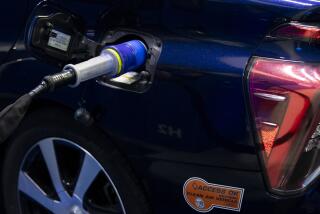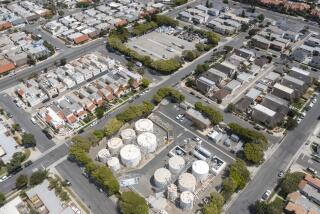It’s a Dirty Job, but . . . : Small Firm Cleans Fuel Tanks and the Contents
- Share via
HUNTINGTON BEACH — It would seem to be a thankless task, right up there with digging ditches and maintaining septic tanks.
But Clean Fuels, a small Huntington Beach firm, has been persuading businesses and city governments that ridding fuel tanks of dirt, grime and sludge is a job that has to be done.
In an age of more stringent state and federal regulations and high fuel prices, nearly half a dozen firms specialize in cleaning fuel tanks. But Clean Fuels says it has the most modern and effective technology to do so, including a six-filter system and snakelike hose.
“It’s not a glorious, glamorous thing,” said Paul Martin, general manager. And convincing a government agency or business of the need for the service isn’t easy, he said. “It’s the expenditure. It’s one more thing. But this is something that is really needed.”
Although the tanks themselves are sealed, the fuel that goes into them typically contains dirt and dust, even water from ordinary condensation. When the contaminated fuel is pumped into a gas tank, a vehicle’s engine can be damaged and even made inoperable.
Clean Fuels, which started in 1985 as a small firm that cleaned tanks for the marine industry in Florida, used new government standards mandating tank testing and replacement as a springboard to persuade companies to get their tanks clean as well. The company now has six locations, most of which are licensed to individual owners.
Most of Clean Fuels’ clients are government agencies or large corporations, which must make sure that emergency generators, truck fleets, fire trucks and police cars will operate at a moment’s notice.
“It’s preventive maintenance,” said Gregg Spleid, office manager of Clean Fuels. “Tanks just sit over many years.
“It’s sort of an out-of-sight, out-of-mind thing. But more and more companies are realizing that it’s cheaper to have preventive maintenance than to wait until there is an earthquake or other emergency and discover their equipment doesn’t work.”
Some companies still rely on the old-fashioned method: emptying the fuel and lowering in a worker to scrub the walls. But the process is dangerous and costly, and it wastes all the fuel that is removed.
By contrast, in the Clean Fuels system, a “dual hose” is dropped to the bottom of a tank. An outer suction hose draws fuel to a series of six filters, capturing contaminants and water. Then the cleaned fuel is returned to the bottom of the tank through the inner, snake-like hose. Because the inner hose operates at a high pressure, it agitates the liquid throughout the tank, loosening debris on the walls. The cycle is repeated until the fuel is clean.
Clean Fuels takes the waste to a refiner, which siphons off gas and makes it into kerosene and diesel fuels. Particles are converted to oil-based asphalt. Water is distilled and evaporated.
“It is 100% recycling,” Martin said. “There’s nothing going in the ground.”
The entire service costs from $100 to $1,000 for a tank, depending on the size and the volume of business a customer does.
The company says its process is unmatched and more effective than any other. Competitors, however, say they can offer the same quality of service at a lesser cost.
Dialysis Co., a Van Nuys firm, says its system of patented filters and specially designed tubing does the job just as well at a rate of $225 to $250 for each tank, plus $45 for filters and $25 to haul waste away.
“There are companies out there who overcharge their customers just because they know they need their help,” said Tamara Zimmerman, office manager for Dialysis. After a treatment by Dialysis, she said, a tank “will be as clean as if you just went to the refinery and bought it. That’s how clean it is.”
Dialysis, which has specialized for more than 25 years in cleaning fuel tanks, had little competition until the mid-1980s, when the U.S. Environmental Protection Agency and state Water Resources Control Board imposed new restrictions that require periodic testing of fuel tanks for leaks, as well as replacement or relining of old ones.
It remains to be seen whether the fuel-tank cleaning business will catch on for smaller jobs, such as automobile gas tanks.
Cleaning Fuel Tanks How a Clean Fuels system works to remove debris and contaminants from automobiles, boats, motor homes and industrial tanks: 1. A dual hose system is inserted into the tank. 2. Outer hose suctions fuel into canisters through a series of filters, capturing contaminants and separating water from fuel. 3. The cleaned fuel is sent back into the tank through the high-pressure hose. Agitation from the hose loosens debris from the walls and bottom of the tank. 4. The simultaneous agitation and filtration process repeats itself until both the fuel and the tank are free of contaminants. Source: Clean Fuels International
Inside Tanks
Fuel tanks collect contamination and debris that can cause decreased performance, costly repairs and damage to vehicle tanks and engines.
The Culprits
Water: Enters through condensation or during fuel delivery.
Algae: Enters with water; it lives in the water and uses the fuel as a food source.
Sludge and rust: Formed from water, particulates and algae that settle on the bottom of the tank.
Particulates: Routinely found in the fuel supply; they are about half the size of fuel-injector openings.
Source: Clean Fuels International
More to Read
Sign up for Essential California
The most important California stories and recommendations in your inbox every morning.
You may occasionally receive promotional content from the Los Angeles Times.










